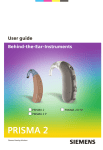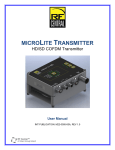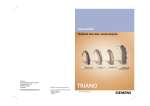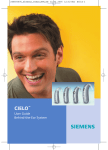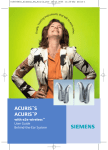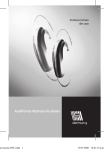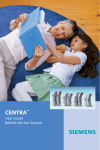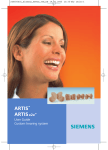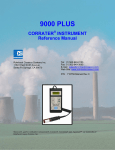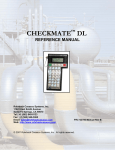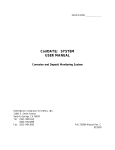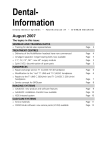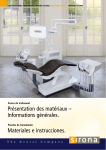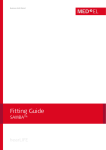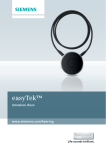Download Siemens MUSIC Pro User's Manual
Transcript
MUSIC Pro User Guide Behind-the-Ear Instruments s Siemens Hearing Solutions A friendly guide to your new Siemens hearing instruments Congratulations! You have decided in favour of hearing instruments from Siemens. You have taken an important step towards being able to hear better. From now on, your new hearing instruments will be your constant companions. You will profit from our many years of research and experience in microelectronics. Soon it will be easy for you to hear again. Good hearing is an important requirement for your physical well being. Your new hearing instruments will help you actively participate with pleasure in the world of language and music again. And as with any constant companion, you’ll need some time at first to get used to handling your hearing instruments. With a little patience, we trust that your new hearing experience will be all the more pleasant for you. These user guide should help you build friendship quickly with your new partners in matters relating to better hearing. We want to help you to handle your hearing instruments correctly, so that they will become an important part of your life. Wishing you much success, Your Siemens team 2 The best way to use your new hearing instruments In this brief guide you will find instructions for inserting, placing and adjusting your hearing instruments. There are also tips and information on correct handling, cleaning, care and battery changing. And naturally information about how you can solve some failures yourself if you cannot visit a hearing instrument specialist immediately. One important note: Your hearing success depends largely on how well your instruments fit in the ears and how carefully you maintain and handle them. This is your Instrument Contents: MUSIC Pro Page 5 Pro MUSIC Pro S Page 15 Pro S MUSIC Pro SP Page 23 Pro SP MUSIC Pro Dir Page 31 Pro Dir All Applicable to all INFINITI Pro instruments How to insert your ear mould Page 42 Handling batteries Page 44 Notes for cleaning and care Page 45 The best way to handle your hearing instruments Page 47 How to solve some failures yourself Page 48 Hearing training made easy Page 51 3 4 MUSIC Pro Description of the MUSIC Pro hearing instrument Page 6 Battery changing Page 7 Safety notes for batteries Page 8 How to switch your instrument on/off Page 9/10 Setting the loudness Page 9 Program button Page 10 Telecoil Page 11 Audio input program Page 12 Battery compartment lock Page 13 Pro Applicable to all MUSIC Pro instruments How to insert your ear mould Page 42 Handling Batteries Page 44 Notes for cleaning and care Page 45 The best way to handle your hearing instruments Page 47 How to solve some failures yourself Page 48 Hearing training made easy Page 51 5 Description of the MUSIC Pro hearing instrument Microphone opening Volume Control Programming socket Program button with on/off function Battery compartment with on/off function and lock For your instrument you will need Battery Type 13. 6 Battery changing You should always pull off the protective foil only if you actually use the battery. Pro Open the battery compartment Insert the battery Close the battery compartment When inserting the battery please pay attention to the plus side on the battery. The plus (+) side of the battery is always the smooth side. You can recognise the minus (–) side by the coloured ring. You should always keep spare batteries at hand. If you feel you cannot change the battery yourself, ask someone to help you: a family member, friend or your hearing instrument specialist. 7 The batteries last from a few days up to several weeks according to the way they are used. You can recognise when a change of batteries becomes necessary, because your hearing instruments become noticeably quieter towards the end of the battery’s life. Then it is time for new batteries. Two warning tones sound once per minute indicating that you must insert a new battery. 1 min. Your hearing instrument specialist can switch off the warning tones if required. Safety notes for batteries WARNING Keep batteries away from children! Batteries must not be swallowed. Remove the batteries when the instrument is not in use over a prolonged period. Replace leaking batteries without delay. Do not throw away your dead batteries! Return them to your hearing instrument specialist for proper, environmentally conscious disposal. 8 How to switch your instrument on/off fig. 1 Push to switch ”OFF” fig. 2 Push to switch ”ON” There are 2 ways to switch your Instruments ON/OFF. First way Press the battery compartment to the rear up to the first stop in order to switch OFF the instrument. Please note: if you press further than to the first stop, the battery might fall out! (see fig. 1) Close the battery compartment to switch ON the instrument (see fig. 2) Second way is by using the program button. See chapter “Program button”. Setting the loudness MUSIC Pro hearing instruments are fully automatic. It is therefore not necessary for you to change the loudness manually. However, if you still wish to do so, MUSIC Pro offers you a volume control. louder 2 turn quieter Your hearing instrument specialist can program the possible adjustment range for you. If you do not want to use the volume control, then your hearing instrument specialist can also switch it off. 9 Pro Program button How to switch your instrument ON/OFF If the hearing instrument has already been operated it can be switched off by pressing the program button for at least 2 sec. To switch it on again press the program button for at least 2 sec. The instrument diverts to program “1”. Every operation is acknowledged by beeps tones. How to select the programs MUSIC Pro has 4 hearing programs. Program 1 to 3 is selected with the program button. Program 4 is activated by the audio shoe. Each time when the instrument diverts between the programs, the respective program is confirmed by beep tones. The number of beep tones is identical with the selected program. That means when program “3“ is selected, three beep tones are heard. Program overview See below to check how your hearing instrument specialist has programmed your MUSIC Pro instrument. Hearing program beeps your MUSIC Pro 1 2 3 4 10 audio shoe Telecoil The telecoil is intended for telephone conversations and for using induction loops, e.g. in churches, theaters or lecture rooms. In order to be able to use the telephone coil, your telephone also must be suitable for hearing instruments and emit an adequate magnetic field. It is mostly older telephones which meet these requirements. Unfortunately, modern phones, particularly cordless telephones and mobile phones, do NOT all emit a magnetic field. In these cases we recommend that you use the normal hearing programs for telephone conversations (see also pages 53/54). Pro 11 Audio input program Your hearing instrument has an audio input. This enables accessories to be connected. In this way you can understand better in certain hearing situations. The contacts for the audio input are located under the type plate. Before using the audio input for the first time the covering type plate must be exchanged against the supplied type plate providing openings for the audio contacts. Your hearing instrument specialist will do this for you. The coloured type plates can be used to identify your left (blue) and right (red) hearing instrument. Your hearing instrument recognises immediately when an audio shoe is fitted and diverts then automatically to pro. gram ”4”. You can notice this by the four beep tones Fitting the audio shoe to the hearing instrument Hook the audio shoe in from the front and press it to the rear into the detent on the inner curve of the instrument. 1 2 3 Safety note for instruments with audio input The audio input can only be connected to power supplied devices if they fulfil at least the safety provisions of IEC 65 / DIN VDE 0860. 12 Battery compartment lock Your instruments are equipped with a battery compartment lock. This is intended to prevent the unintentional removal of batteries from their compartment, such as by small lock children. To lock the battery comunlock partment open the battery compartment up to the first stop. Push the slide in the battery compartment to the right with a suitable tool. To unlock the battery compartment again, open the battery compartment up to the first stop. Push the slide in the battery compartment to the left with a suitable tool. If you feel you cannot do this yourself, your hearing instrument specialist will be pleased to help you. 13 Pro 14 MUSIC Pro S Description of the MUSIC Pro S hearing instrument Page Battery changing Page 17 Safety notes for batteries Page 18 How to switch your instrument on/off Page19/20 Battery compartment lock Page 16 Pro S 19 Program button Page 20 Telecoil Page 21 Applicable to all INFINITI Pro instruments How to insert your ear mould Page 42 Handling Batteries Page 44 Notes for cleaning and care Page 45 The best way to handle your hearing instruments Page 47 How to solve some failures yourself Page 48 Hearing training made easy Page 51 15 Description of the MUSIC Pro S hearing instrument Microphone opening Programming socket Program button with on/off function Battery compartment with on/off function and lock For your instrument you will need Battery Type 13. 16 Battery changing You should always pull off the protective foil only if you actually use the battery. ▼ Open the battery compartment ▼ ▼ Insert the battery Pro S Close the battery compartment When inserting the battery please pay attention to the plus side on the battery. The plus (+) side of the battery is always the smooth side. You can recognise the minus (–) side by the coloured ring. You should always keep spare batteries at hand. If you feel you cannot change the battery yourself, ask someone to help you: a family member, friend or your hearing instrument specialist. 17 The batteries last from a few days up to several weeks according to the way they are used. You can recognise when a change of batteries becomes necessary, because your hearing instruments become noticeably quieter towards the end of the battery’s life. Then it is time for new batteries. Two warning tones indicate that you must insert a new battery. 1 min. Your hearing instrument specialist can switch off the warning tones if required. Safety notes for batteries WARNING Keep batteries away from children! Batteries must not be swallowed. Remove the batteries when the instrument is not in use over a prolonged period. Replace leaking batteries without delay. Do not throw away your dead batteries! Return them to your hearing instrument specialist for proper, environmentally conscious disposal. 18 How to switch your instrument on/off fig. 1 Push to switch ”OFF” fig. 2 Push to switch ”ON” There are 2 ways to switch your Instruments ON/OFF. First way Press the battery compartment to the rear up to the first stop in order to switch OFF the instrument. Please note: if you press further than to the first stop, the battery might fall out! (see fig. 1) Close the battery compartment to switch ON the instrument (see fig. 2) Second way is by using the program button. See chapter “Program button” . Pro S Battery compartment lock Your instruments are equipped with a battery compartment lock. This is intended to prevent the unintentional removal of batteries from their compartment, such as by small children. lock unlock To lock the battery compartment device open the battery compartment up to the first stop. Push the slide in the battery compartment to the right with a suitable tool. 19 To unlock the battery compartment again, open the battery compartment up to the first stop. Push the slide in the battery compartment to the left with a suitable tool. If you feel you cannot do this yourself, your hearing instrument specialist will be pleased to help you. Program button How to switch your instrument ON/OFF If the hearing instrument has already been operated it can be switched off by pressing the program button for at least 2 sec. To switch it on again press the program button for at least 2 sec. The instrument diverts to program “1” . Every operation is acknowledged by beeps tones. How to select the programs The MUSIC Pro S has 3 hearing programs which are selected with a program button. Each time the button is pressed the instrument diverts to the next program which is confirmed with a beep tone. The number of beep tones is identical with the selected program. That means when program “3“ is selected 3 beep tones are heard. Program overview See below to check how your hearing instrument specialist has programmed your INFINITI Pro S instrument. Hearing program 1 2 3 20 beeps your INFINITI Pro S Telecoil The telecoil is intended for telephone conversations and for using induction loops, e.g. in churches, theaters or lecture rooms. In order to be able to use the telephone coil, your telephone also must be suitable for hearing instruments and emit an adequate magnetic field. It is mostly older telephones which meet these requirements. Unfortunately, modern phones, particularly cordless telephones and mobile phones, do NOT all emit a magnetic field. In these cases we recommend that you use the normal hearing programs for telephone conversations (see also pages 53/54). Pro S 21 22 MUSIC Pro SP Description of the INFINITI Pro SP hearing instrument Page 24 Battery changing Page 25 Safety notes for batteries Page 26 How to switch your instrument on/off Page 27/28 Setting the loudness Page 27 Program button Page 28 Telecoil Page 29 Audio input program Page 29 Battery compartment lock Page 30 Page 42 Handling Batteries Page 44 Notes for cleaning and care Page 45 Pro SP Applicable to all MUSIC Pro instruments How to insert your ear mould The best way to handle your hearing instruments Page 47 How to solve some failures yourself Page 48 Hearing training made easy Page 51 23 Description of the MUSIC Pro SP hearing instrument Microphone opening Volume Control Programming socket Program button with on/off function Battery compartment with on/off function and lock For your instrument you will need Battery Type 675. 24 Battery changing You should always pull off the protective foil only if you actually use the battery. Pro SP Open the battery compartment Insert the battery Close the battery compartment When inserting the battery please pay attention to the plus side on the battery. The plus (+) side of the battery is always the smooth side. You can recognise the minus (–) side by the coloured ring. You should always keep spare batteries at hand. If you feel you cannot change the battery yourself, ask someone to help you: a family member, friend or your hearing instrument specialist. 25 The batteries last from a few days up to several weeks according to the way they are used. You can recognise when a change of batteries becomes necessary, because your hearing instruments become noticeably quieter towards the end of the battery’s life. Then it is time for new batteries. Two warning tones sound once per minute indicating that you must insert a new battery. 1 min. Your hearing instrument specialist can switch off the warning tones if required. Safety notes for batteries WARNING Keep batteries away from children! Batteries must not be swallowed. Remove the batteries when the instrument is not in use over a prolonged period. Replace leaking batteries without delay. Do not throw away your dead batteries! Return them to your hearing instrument specialist for proper, environmentally conscious disposal. 26 How to switch your instrument on/off fig. 1 Push to switch ”OFF” fig. 2 Push to switch ”ON” There are 2 ways to switch your Instruments ON/OFF. First way Press the battery compartment to the rear up to the first stop in order to switch OFF the instrument. Please note: if you press further than to the first stop, the battery might fall out! (see fig. 1) Close the battery compartment to switch ON the instrument (see fig. 2) Second way is by using the program button. See chapter “Program button”. Pro SP Setting the loudness MUSIC Pro SP hearing instruments are fully automatic. It is therefore not necessary for you to change the loudness manually. However, if you still wish to do so, MUSIC Pro SP offers you a volume control. louder 2 turn quieter If you do not want to use the volume control, then your hearing instrument specialist can also switch this off. 27 Program button How to switch your instrument ON/OFF If the hearing instrument has already been operated it can be switched off by pressing the program button for at least 2 sec. To switch it on again press the program button for at least 2 sec. The instrument diverts to program “1” . Every operation is acknowledged by beeps tones. How to select the programs MUSIC Pro SP has 4 hearing programs. Program 1 to 3 is selected with the program button. Program 4 is activated by the audio shoe. Each time when the instrument diverts between the programs, the respective program is confirmed by beep tones. The number of beep tones is identical with the selected program. That means when program “3“ is selected, three beep tones are heard. Program overview See below to check how your hearing instrument specialist has programmed your MUSIC Pro SP instrument. Hearing program beeps your MUSIC Pro SP 1 2 3 4 28 audio shoe Telecoil The telecoil is intended for telephone conversations and for using induction loops, e.g. in churches, theaters or lecture rooms. In order to be able to use the telephone coil, your telephone also must be suitable for hearing instruments and emit an adequate magnetic field. It is mostly older telephones which meet these requirements. Unfortunately, modern phones, particularly cordless telephones and mobile phones, do NOT all emit a magnetic field. In these cases we recommend that you use the normal hearing programs for telephone conversations (see also pages 53/54). Pro SP Audio input program Your hearing instruments are equipped with an audio input. This enables the connection between hearing instrument and accessories. It helps you to understand better in certain hearing situations. Your hearing instrument recognises immediately when an audio shoe is fitted and diverts then automatically to pro. gram ”4”. You can notice this by the four beep tones Fitting an audio shoe Open the battery compartment up to the first stop, open the flap under the push button, hook the audio shoe in from the front and press it to the rear into the detent on the inner curved piece. 29 Switching off instrument with audio shoe Press the audio shoe to the rear, up to the first stop. Removing the audio shoe Press the audio shoe to the front, unhook the audio shoe and close the flap again. Safety instructions for hearing instruments with audio input The audio input may be connected to line-operated equipment only if this fulfils at least the safety requirements of IEC 65 / DIN VDE 0860. Battery compartment lock Your instruments are equipped with a battery compartment lock. This is intended to prevent the unintentional removal of batteries from their compartment, such as by small children. To lock the battery compartment open the battery compartment up to the first stop. Push the slide in the battery compartment to the right with a suitable tool. To unlock the battery compartment again, open the battery compartment up to the first stop. Push the slide in the battery compartment to the left with a suitable tool. If you feel you cannot do this yourself, your hearing instrument specialist will be pleased to help you. 30 MUSIC Pro Dir Description of the MUSIC Pro Dir hearing instrument Page 32 Battery changing Page 33 Safety notes for batteries Page 34 How to switch your instrument on/off Page 35/36 Setting the loudness Page 35 Program button Page 36 Telecoil Page 37 Audio input program Page 38 Battery compartment lock Page 39 ProDir Applicable to all MUSIC Pro Dir instruments How to insert your ear mould Page 42 Handling batteries Page 44 Notes for cleaning and care Page 45 The best way to handle your hearing instruments Page 47 How to solve some failures yourself Page 48 Hearing training made easy Page 51 31 Description of the MUSIC Pro Dir hearing instrument Microphone openings Volume Control Programming socket Program button with on/off function Battery compartment with on/off function and lock For your instrument you will need Battery Type 13. 32 Battery changing You should always pull off the protective foil only if you actually use the battery. ProDir Open the battery compartment Insert the battery Close the battery compartment When inserting the battery please pay attention to the plus side on the battery. The plus (+) side of the battery is always the smooth side. You can recognise the minus (–) side by the coloured ring. You should always keep spare batteries at hand. If you feel you cannot change the battery yourself, ask someone to help you: a family member, friend or your hearing instrument specialist. 33 The batteries last from a few days up to several weeks according to the way they are used. You can recognise when a change of batteries becomes necessary, because your hearing instruments become noticeably quieter towards the end of the battery’s life. Then it is time for new batteries. Two warning tones sound once per minute indicating that you must insert a new battery. 1 min. Your hearing instrument specialist can switch off the warning tones if required. Safety notes for batteries WARNING Keep batteries away from children! Batteries must not be swallowed. Remove the batteries when the instrument is not in use over a prolonged period. Replace leaking batteries without delay. Do not throw away your dead batteries! Return them to your hearing instrument specialist for proper, environmentally conscious disposal. 34 How to switch your instrument on/off fig. 1 Push to switch ”OFF” fig. 2 Push to switch ”ON” There are 2 ways to switch your Instruments ON/OFF. First way Press the battery compartment to the rear up to the first stop in order to switch OFF the instrument. Please note: if you press further than to the first stop, the battery might fall out! (see fig. 1) Close the battery compartment to switch ON the instrument (see fig. 2) Second way is by using ProDir the program button. See chapter “Program button” . Setting the loudness MUSIC Pro Dir hearing instruments are fully automatic. It is therefore not necessary for you to change the loudness manually. However, if you still wish to do so, MUSIC Pro Dir offers you a volume control. louder 2 turn quieter Your hearing instrument specialist can program the possible adjustment range for you. If you do not want to use the volume control, then your hearing instrument specialist can also switch it off. 35 Program button How to switch your instrument ON/OFF If the hearing instrument has already been operated it can be switched off by pressing the program button for at least 2 sec. To switch it on again press the program button for at least 2 sec. The instrument diverts to program “1”. Every operation is acknowledged by beeps tones. How to select the programs MUSIC Pro Dir has 4 hearing programs. Program 1 to 3 is selected with the program button. Program 4 is activated by the audio shoe. Each time when the instrument diverts between the programs, the respective program is confirmed by beep tones. The number of beep tones is identical with the selected program. That means when program “3“ is selected, three beep tones are heard. Program overview See below to check how your hearing instrument specialist has programmed your MUSIC Pro Dir instrument. Hearing program beeps your MUSIC Pro Dir 1 2 3 4 36 audio shoe Telecoil The telecoil is intended for telephone conversations and for using induction loops, e.g. in churches, theaters or lecture rooms. In order to be able to use the telephone coil, your telephone also must be suitable for hearing instruments and emit an adequate magnetic field. It is mostly older telephones which meet these requirements. Unfortunately, modern phones, particularly cordless telephones and mobile phones, do NOT all emit a magnetic field. In these cases we recommend that you use the normal hearing programs for telephone conversations (see also pages 53/54). ProDir 37 Audio input program Your hearing instrument has an audio input. This enables accessories to be connected. In this way you can understand better in certain hearing situations. The contacts for the audio input are located under the type plate. Before using the audio input for the first time the covering type plate must be exchanged against the supplied type plate providing openings for the audio contacts. Your hearing instrument specialist will do this for you. The coloured type plates can be used to identify your left (blue) and right (red) hearing instrument. Your hearing instrument recognises immediately when an audio shoe is fitted and diverts then automatically to pro. gram ”4”.You can notice this by the four beep tones Fitting the audio shoe to the hearing instrument Hook the audio shoe in from the front and press it to the rear into the detent on the inner curve of the instrument. 1 2 3 Safety note for instruments with audio input The audio input can only be connected to power supplied devices if they fulfil at least the safety provisions of IEC 65 / DIN VDE 0860. 38 Battery compartment lock Your instruments are equipped with a battery compartment lock. This is intended to prevent the unintentional removal of batteries from their compartment, such as by small lock children. To lock the battery comunlock partment open the battery compartment up to the first stop. Push the slide in the ProDir battery compartment to the right with a suitable tool. To unlock the battery compartment again, open the battery compartment up to the first stop. Push the slide in the battery compartment to the left with a suitable tool. If you feel you cannot do this yourself, your hearing instrument specialist will be pleased to help you. 39 40 Applicable to all MUSIC Pro instruments MUSIC Pro MUSIC Pro S MUSIC Pro SP MUSIC Pro Dir How to insert your ear mould Page 42 Handling batteries Page 44 Notes for cleaning and care Page 45 All The best way to handle your hearing instruments Page 47 How to solve some failures yourself Page 48 Hearing training made easy Page 51 41 How to insert your ear mould Make sure that your hearing instrument is turned off. The battery compartment must be opened up to the stop. Grip the ear mould between your thumb and index finger and place the tip carefully into your auditory canal. You may find it helpful to pull your ear slightly upwards or to the rear. You may want to push the ear mould very gently with your index finger. Once inserted, you should feel that the ear mould is correctly placed. Now place your hearing instrument behind your ear and switch it on. Close the battery compartment fully. 42 Tip: Practice inserting and removing your hearing instruments correctly. One easy way to practice is to sit down at a table. Place a mirror in front of you and prop your elbows on the table so you can guide your hands easily and safely.This will help you stay relaxed and comfortable while you practice. All 43 Handling batteries So-called zinc-air batteries are used today almost exclusively in hearing instruments to minimize environmental damage. These batteries require oxygen for operation, which they absorb from the air. The battery is activated as soon as the protective foil is pulled off and is used up even if you do not use your hearing instrument. You should always pull off the protective foil only if you actually use the battery. Also, do not leave the batteries in your hearing instruments if you do not use them over a longer period of time. The batteries can leak and damage the instruments. Zinc-air batteries which are almost completely used up show the following behaviour: After switching on the instruments they function completely normally, but then rapidly become quieter. The more the battery is used up, the faster the gain falls off. You must then replace such batteries by new ones. 44 Notes for cleaning and care Ear wax accumulates on your ear mould. This can lead to inflammation in your auditory canal if the instruments are not cleaned regularly. Therefore: 1. It is essential to detach the ear mould from your behindthe-ear instrument and place it in a cleaning bath for at least 15 minutes. Caution: The hearing instrument itself cannot tolerate any moisture. All 2. Bring your hearing instruments regularly to your hearing instrument specialist, on the schedule that he or she recommends, to have the hearing tube changed and the instrument checked. 45 Two more tips: You should place your hearing instruments in a “dry bag“ with a special moisture-attracting capsule overnight.The drying capsule draws damaging moisture out of the instruments. Your hearing instrument specialist stocks the special care sets and dry bags you need to maintain your hearing instruments and keep them in good condition. 46 The best way to handle your hearing instruments Your new hearing instruments are highly sensitive instruments. This naturally requires some care in their handling. They should then always give you good service. All Caution! As with all electrical, non gas-encapsulated instruments, the hearing instruments must not be operated in explosion-endangered rooms. 47 How to solve failures yourself In selecting your MUSIC Pro hearing instruments you have chosen extremely dependable devices. However, should a fault occur, it can usually be corrected quickly. Important tips: If the instrument whistles Test the instrument yourself by covering the sound outlet opening with your fingertip. If the whistling disappears, the instrument is in order. Check that the ear mould sits properly in your ear. Also test the hearing tube for leaks. If the whistling noise is still audible, only your hearing instrument specialist can provide assistance. Sound outlet opening 48 If the hearing instrument is too quiet Most likely, you need to insert a new battery. If it is still too quiet, clean the instrument or the ear mould and hearing tube, following the directions in the chapter “Notes for cleaning and care“ . If neither a new battery nor cleaning helps, as a precaution you should ask your hearing instrument specialist to test your hearing again. If the hearing instrument does not work at all Is the instrument turned on? Is the battery compartment completely closed? Is the battery inserted correctly? Is it possible that the battery is dead? If none of these hints help, you should visit your hearing instrument specialist. All 49 Some useful tips: Never expose your hearing instruments to extreme temperatures or high humidity. Never let them lie in the blazing sun. Do not wear them when taking a shower or when using hairspray. In short-wave therapy or if you work or are medically treated with strong magnetic or high-frequency fields or X-rays, under no circumstances may you wear the instruments during the therapy. Make sure to switch off the instruments when not in use.This saves the batteries. If you don’t wear your instruments for a longer time, remove the batteries. Batteries can leak out. Replace batteries that have leaked out without delay. 50 Hearing training made easy Hearing instruments reproduce an abundance of sounds which frequently haven’t been experienced for many years. Every person reacts differently the first time he or she wears a hearing instrument. The familiarisation phase therefore differs from person to person. There are people who are quite happy to wear their hearing instruments the whole day long right from the start. Others will regard it as a foreign body at first. You’ll notice that even after a relatively short time the positive new hearing experience prevails and you’ll find your hearing instruments to be something quite normal. Hearing training helps you here. You’ll become more and more perfect, and naturally securer, step by step. 1st step All Discover simple sounds in your direct surroundings Wear your instruments in different situations in different rooms. Repeat this exercise and you’ll become more and more familiar with the sounds. 2nd step Experience sounds outdoors First choose quiet surroundings for this. For instance, while taking a stroll you’ll discover all sorts of sounds in the ”silence” of the forest. 51 3rd step Become familiar with your own voice You’ve already made remarkable progress! You’ve become much more familiar with the sounds in your daily environment. As an exercise read out aloud and concentrate on your own voice. 4th step Learn to understand the voices of others Wear the instrument when you speak with someone in your family. Make a date with a friend. Explain your new situation and ask the person you’re talking to to speak at a normal conversational level. Exercise: Have sentences read out to you and repeat these sentences. 5th step Get used to conversations in a group Conversation in a group of people speaking among themselves is one of the most difficult hearing situations. Try to distinguish between the voices by noting their specific tonal colour and their characteristic rhythm, and fit them to the individual persons. Don’t be discouraged and repeat the exercise – think about your goal: to be able to take part in conversations again. 52 6th step Visit public events At lectures or in church find a place as close as possible to the speaker. Also choose a place at the front in theaters and concert halls. Avoid niches, boxes and places behind pillars. 7th step Telephoning with your hearing instrument There are two different methods for telephoning while wearing your hearing instrument: 1. Using the normal hearing program: The sound from the telephone receiver is absorbed directly by the microphone of your hearing instrument. Hold the receiver approx. 1-2 cm away from your ear. It is not necessary to change the program. 2. Inductive telephoning by means of the telecoil: This is only possible if your hearing instrument is fitted with a telecoil and program button. If this is the case, then follow these instructions: Using the telecoil In order to use the telecoil for telephone conversations the telephone itself must emit an adequate magnetic field for the hearing instrument. In most cases, it is the older telephones which fulfil this requirement. Press the program button to switch to the special telecoil program. Then place the telephone receiver against your ear and listen for the position with the loudest transmission. Note: Most of the modern telephones, particularly cordless telephones and mobile phones, do NOT emit a magnetic field. When phoning from these appliances, you should use the normal hearing programs. 53 All Further benefit: You can use the telecoil program in order to be able to hear better in churches, theaters and lecture rooms which are fitted with induction loops. If you have two hearing instruments, set them both to the telephone coil program. Your hearing instruments fulfil the IEC 118-13 standard with regard to electromagnetic compatibility (concerning for example interference by radiotelephones which are used close-by). If you use a mobile telephone (GSM), there will be hardly any interference, because of the high EMC stability. If you should still experience some interference, even though this may be unpleasant, there is no reason for concern. Your hearing instruments are not defective. You should discuss this problem with your hearing instrument specialist. 8th step Go on further voyages of discovery – undertake everything that gives you pleasure and experience the whole wide world of hearing. 54 We’re happy that you can hear well again! Once good hearing returns to your everyday life – and you can enjoy both speech and music again – then we at Siemens are also satisfied. Because we’ve put all our knowledge and skill into developing your hearing instruments! 55 Subject to change without prior notice. Siemens Audiologische Technik GmbH Gebbertstraße 125 91058 Erlangen Germany www.hearing-siemens.com Order-No.: A91100-M5100-B963-03-7600 Printed in Germany 052004.JK 77 84 650


























































